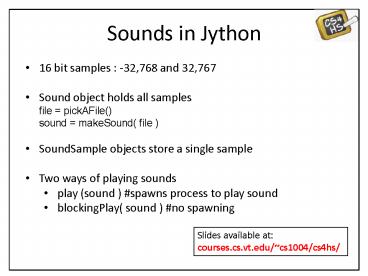Sounds in Jython PowerPoint PPT Presentation
1 / 9
Title: Sounds in Jython
1
Sounds in Jython
- 16 bit samples -32,768 and 32,767
- Sound object holds all samplesfile
pickAFile()sound makeSound( file ) - SoundSample objects store a single sample
- Two ways of playing sounds
- play (sound ) spawns process to play sound
- blockingPlay( sound ) no spawning
Slides available atcourses.cs.vt.edu/cs1004/cs4
hs/
2
Sound Samples
- Samples retrieved either as
- collection/array of SoundSample
objectscollection______________________________
______for sample in getSamples( sound)
setSampleValue( sample, getSampleValue(sample)2)
array_______________________________________s
amples getSamples( sound)for s in range(0,
getNumSamples(sound)) half getSampleValue(
sampless ) / 2 setSampleValue( sampless,
half ) - single SoundSample objectssample
getSampleObjectAt( sound, 100 )
3
Normalize a Sound
- Normalizing sounds involves making them as loud
as possibledef driver() file pickAFile()
sound makeSound( file ) blockingPlay( sound
) normalize( sound ) blockingPlay( sound
)def normalize( source ) - large 0
- for snd in getSamples(source)
- large max(large, abs(getSample(snd)) )
- scaler 32767.0 / large
- for snd in getSamples(source)
- loud scalergetSample(snd)
- setSample(snd, loud)
Code available atcourses.cs.vt.edu/cs1004/cs4hs
/
4
Reverse a sound
- In late 1969 a rumor started circulating that
Paul McCartney of the Beatles had died in 1966
and had been replaced by a double. To support
this urban legend many reported that if one
played the song "Revolution 9" from the white
album backwards one could hear "Turn me on, dead
man". - Reverse the last 15 seconds of the song
"Revolution 9" from the white album rev9.wav - Modify the normalize code by adding a reverse()
function that swaps all the samples in a sound,
(first last, second next-to-last, etc.). - Extra-credit do not modify the original sound.
5
Fade Outs
- Create a new sound from copies of a sound, where
the copies fade out with a delay between the
copies
def fadeOut( snd1, delay, num ) s1rate
getSamplingRate(snd1) ends1 getLength( snd1
) snd2 makeEmptySound( ends1 (num 1)
num int(delay s1rate) ) ends2 getLength(
snd2 ) fadeAmplitude 1.0 posn2 0 for
echoCount in range( 0, num 1 ) for posn1
in range( 0, ends1-1 ) values1
getSampleValueAt( snd1, posn1) fadeAmplitude
setSampleValueAt( snd2, posn2, values1 )
posn2 posn2 1 if (echoCount lt num)
for pause in range(0, int(s1rate delay))
setSampleValueAt( snd2, posn2, 0 )
posn2 posn2 1 fadeAmplitude
fadeAmplitude 0.6 each fade is 60 of
previous return snd2
Code available atcourses.cs.vt.edu/cs1004/cs4hs
/
6
Blending Sounds
- Creates a new sound from existing sounds.
- Corresponding samples from the sounds are blended
together. - Blending involves adding percentages (50) of
each sample together. - Lab/class activity download a reading of the
Gettysburg address and an instrumental recording
of God Bless America and create a blending of the
two, (i.e. sound mix).
7
ALVIN! Lurch?
- Sounds can be speeded up or slowed down by
under-sampling or over-sampling. - Here is a famous line from the classic Paul
Newman movie "Cool Hand Luke" as spoken by the
inimitable character actor Strother Martin
FailureToCommunicate.wav - Code a function to speed up the sound by creating
a new sound half as long as the original using
every other sample from the original. - Code a function to slow down the sound by
creating a new sound twice as long as the
original using every sample from the original
twice.
8
Interpolation
- Under-sampling or over-sampling are just specific
instances of linear interpolation (the same as
nearest neighbor in image scaling). - Given a length (sampling) factor, e.g., 0.80,
1.15, return a new sound of the new length and
sampling using linear interpolation. - Linear Interpolation
x
For any new sound sample s the corresponding
sample x from the original sound s / (length
of new sound) length of original sound
9
Sound Projects
- Simple Telephony
- Given sound clips for each spoken digit, combine
them to speak any given number. - Sound Steganography
- Hide a message inside a sound file
- http//www.cs.uic.edu/i101/projects/proj4.html
- Mozarts Dice Game
- Create a waltz by pasting together pre-composed
minuet trio clips. - http//www.cs.cornell.edu/courses/cs1110/2008fa/as
signments/a6/a6.html

